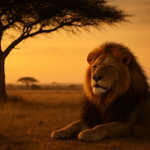The lion holds a universal and almost primal place in the human imagination. We call it the “king of the jungle” without a second thought, seeing in its golden gaze an elemental symbol of power, courage, and royalty. But this powerful identity, which graces everything from national flags to childhood fables, is less a reflection of the animal itself and more a mirror of our own complex history.
The first clue to this manufactured mythology lies in that very title. Lions, as we know, are creatures of the savanna and open plains, not dense tropical rainforests. This paradox, however, is not a simple mistake but a ghost of a forgotten meaning, haunting our modern language. The English word “jungle” descends from the Sanskrit jangala, which originally meant “wilderness” or “uninhabited land.” In that ancient context, the lion was indeed the undisputed king of the jangala. The error is not in the title, but in our memory of the word.
This linguistic fossil is just the first crack in the facade. The popular understanding of the lion is a fascinating and often counter-intuitive collage, pieced together from deliberate religious campaigns, theological retrofitting, and the strange, rigid rules of human symbolism. Here, we will deconstruct this man-made mythology to reveal the surprising truths behind the lion’s long cultural reign.
His Reign Was the Result of an Ancient PR Campaign
Before the lion’s ascent, another creature held the crown. For much of early European history, the bear was widely considered the “King of Beasts.” Revered by pagan groups, including the Celtic and Germanic peoples, it was a potent symbol of royalty and primal power. This deep-seated veneration posed a formidable obstacle to Christian missionaries, who saw its symbolic authority as a direct threat to their own.
What followed was nothing short of a deliberate and systematic character assassination. To weaken the bear’s pagan hold, the Church orchestrated a campaign to discredit it, reframing the once-noble animal as a monstrous, gluttonous, and demonic creature. As the bear underwent this symbolic dethroning, missionaries strategically promoted a rival from the lands of the Bible: the lion. Hailing from northern Africa and Palestine, the lion was presented as a righteous emblem of Christ, a guardian of the faith, and the perfect icon for a new class of Christian knights. By the 13th century, the campaign was a resounding success. The bear was vanquished in the cultural imagination, and the lion was firmly installed as the new, sanctified king of beasts across Europe.
A Lion’s Roar Was Believed to Conquer Death
Having successfully orchestrated this symbolic coup, medieval theologians began the crucial work of retrofitting the lion’s perceived habits into the very fabric of Christian allegory. One of the most captivating examples of this theological appropriation comes from the bestiaries, medieval encyclopedias of animal lore heavily influenced by the second-century text Physiologus.
According to these tales, lion cubs were born stillborn, or “incomplete,” remaining lifeless for three days. On the third day, the father lion would breathe life into his dormant cubs with the power of his mighty roar. The parallel was both deliberate and powerful: the three-day timeline was a direct echo of the resurrection of Jesus on the third day after the Crucifixion. This potent myth was reinforced by the companion belief that lions slept with their eyes open—a trait compared to Christ’s body lying physically dead in the tomb while his divine spirit remained eternally watchful.
In Heraldry, a Walking Lion Wasn’t a Lion—It Was a Leopard
As the lion’s soul was bound to Christ in the bestiary, its image was being codified into the rigid, secular language of power: heraldry. Here, in a world governed by human rules, the animal’s very identity became subject to convention rather than biology. What a lion was called on a coat of arms depended not on its species, but entirely on its posture.
The distinction was bafflingly counter-intuitive. A lion depicted upright on its hind legs in profile—the classic fighting pose—was blazoned as a “lion rampant.” Yet, if that same animal was shown walking with its head turned to face the viewer, it was officially called a “leopard” (or, more formally, passant guardant). These heraldic “leopards” were drawn in every respect as lions, complete with flowing manes and tufted tails, bearing no spots or leopardish features whatsoever. The most famous example of this is the royal arms of England. For centuries, until the end of the 14th century, the iconic “three lions” on the English shield were officially described in blazon as three “leopards.”
The Enduring Power of a Symbol
The lion we see on crests, statues, and flags is not an animal we simply observed, but a symbol we actively built. Its regal identity is a story woven from the threads of linguistic drift, religious strategy, allegorical myth, and the peculiar logic of heraldic tradition. The “king of beasts” reigns not only over the savanna but over a vast, symbolic kingdom we constructed for it in our collective imagination.
This process of myth-making reveals how easily history, language, and power can shape our most deeply held symbols. The lion stands as a stunning case study in how a potent image can be dismantled, repurposed, and filled with new meaning to serve the needs of a new era. And yet, this constructed image continues to resonate powerfully today, speaking to our deepest aspirations for strength and integrity. As cultural symbolism expert Charlotte Kirsten notes:
“Lions are true symbols of courage, power, strength, inner wisdom, leadership, and self-actualization. They venture into our lives when we’re on the verge of making all-important leaps of faith, imploring us to trust not only in ourselves and our direction but our capabilities too.”
Now that we know the lion’s story is so much richer and more deliberately crafted than we thought, what other powerful symbols in our world might be hiding an even more fascinating history?











